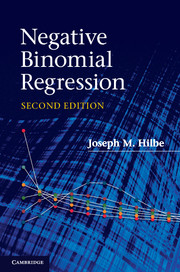Book contents
- Frontmatter
- Contents
- Preface to the second edition
- 1 Introduction
- 2 The concept of risk
- 3 Overview of count response models
- 4 Methods of estimation
- 5 Assessment of count models
- 6 Poisson regression
- 7 Overdispersion
- 8 Negative binomial regression
- 9 Negative binomial regression: modeling
- 10 Alternative variance parameterizations
- 11 Problems with zero counts
- 12 Censored and truncated count models
- 13 Handling endogeneity and latent class models
- 14 Count panel models
- 15 Bayesian negative binomial models
- Appendix A Constructing and interpreting interaction terms
- Appendix B Data sets, commands, functions
- References and further reading
- Index
14 - Count panel models
Published online by Cambridge University Press: 05 June 2012
- Frontmatter
- Contents
- Preface to the second edition
- 1 Introduction
- 2 The concept of risk
- 3 Overview of count response models
- 4 Methods of estimation
- 5 Assessment of count models
- 6 Poisson regression
- 7 Overdispersion
- 8 Negative binomial regression
- 9 Negative binomial regression: modeling
- 10 Alternative variance parameterizations
- 11 Problems with zero counts
- 12 Censored and truncated count models
- 13 Handling endogeneity and latent class models
- 14 Count panel models
- 15 Bayesian negative binomial models
- Appendix A Constructing and interpreting interaction terms
- Appendix B Data sets, commands, functions
- References and further reading
- Index
Summary
Overview of count panel models
A basic assumption in the construction of likelihood-based models is that constituent observations are independent. This is a reasonable assumption for perhaps the majority of studies. However, for longitudinal studies this assumption is not feasible, nor does it hold when data are clustered. For example, observations from a study on student drop-outs can be clustered by the type of schools sampled. If the study is related to intervention strategies, schools in affluent suburban, middle-class suburban, middle-class urban, and below-poverty-level schools have more highly correlated strategies within the school type than between types or groups. Likewise, if we have study data taken on a group of individual patients over time (e.g. treatment results obtained once per month for a year), the data related to individuals in the various time periods are likely to be more highly correlated than are treatment results between patients. Any time the data can be grouped into clusters, or panels, of correlated groups, we must adjust the likelihood-based model (based on independent observations) to account for the extra correlation.
We have previously employed robust variance estimators and bootstrapped standard errors when faced with overdispersed count data. Overdispersed Poisson models were replaced by negative binomial models, by adjusting the variance function of the basic Poisson model, or by designing a new log-likelihood function to account for the specific source of the overdispersion.
- Type
- Chapter
- Information
- Negative Binomial Regression , pp. 447 - 501Publisher: Cambridge University PressPrint publication year: 2011
- 1
- Cited by



